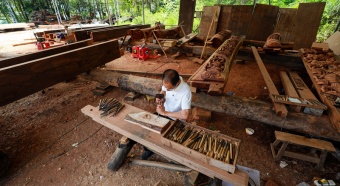Stuck in the scorching summer and heat waves, we three generations had no choice but to go to the air-conditioned supermarket at every night for leisure. As typical “post-80s”, we couple always full our cart with snacks. Yet for my mother who prefer street vegetable markets for intimate price, a trip to supermarket is purely an entertainment and “window shopping”, thus caring for our naughty child becomes her unique task. However, when she saw the houttuynia in the corner of the supermarket, she lost her “principle”.
“9.9 yuan/500G” —— for the price of vegetable, it is a bit extravagant in terms of the consumption level of Yingtan, Jiangxi. Surprisingly, my mother shook off her wait-and-see attitude and put hands of carefully selected houttuynia into a plastic bag. The houttuynia sold in the supermarket was processed, with leaves and roots basically cleaned up, thus my mother seemed quite satisfied with the clean and fresh roots, saying “I will make it a cold dish for you, there is a story behind it!”
Cutting the garlic and pepper, sprinkling the salt and vinegar, and then adding the pepper power and a flavoring, my mother easily made a fresh seasonal cold dish. For me, the niche houttuynia largely existing in Chinese medicine codes has always tied up with the concept of “homology of medicine and food”. The reason why I remember it lies in its special name. Sending a chopstick of houttuynia into the mouth, I felt the reaction of the smell immediately—— it was a kind of shock that was wrapped in a special clear smell, fortunately, a tolerable smell. After that, the taste buds began to work——bitterness, sweetness, sourness and spiciness were not enough to accurately interpret its uniqueness. When we swallowed it into the stomach, pleasures of relief caught us. But the strange thing was that at this moment, there was the urge to continue to put it in the bowl.
Watching us eating the houttuynia with interesting expressions, my mother laughed from ear to ear. This slightly less mainstream food had been the main course of my mother’s family 40 years ago. Unlike people from Provinces of Yunnan, Guizhou and Sichuan, where houttuynia was popular, people at Jiangxi had an indifferent attitude toward it. In the 1950s and 1960s, railway construction surged in Jiangxi, bringing many Sichuan-based railway engineering soldiers to live in here and prosper. In the process, their eating habits also took root, thus multiple ways of eating houttuynia began to pass on by word of mouth.
My grandfather was a porter of the Yingtan-Xiamen Railway, living along the railway near Mount Wuyi with his family. After several times of emotional ups and downs concerning whether to eat houttuynia, and Sichuan workers’ repeated recommendation, he finally put the dish on the table. There was of course a fundamental reason: lack of cooking resources. They could not cook without resources, thus wild vegetables always “steal the show”. My mother recalled that when she was still a girl, every spring, she took her younger siblings to pick the wild vegetables such as purslane, leeks, and green awnings. Later, under the direction of my grandfather, Houttuynia also joined.
Houttuynia is naturally born in the mountains and rivers at the south of the Yangtze River in China, especially in the valleys near the otters, whose natural conditions are perfect for its growth. Although it was based on local materials, my mother still could not enjoy its taste. After all, people at Jiangxi could not totally accept the taste. Yet limited by economic conditions, the family often had to rush through with a bowl of pumpkin porridge and a cold dish of houttuynia flavored by mere salt and self-made peppers.
In 1979, my mother assumed the position of her father as a porter in Hengfeng, Jiangxi. Her leader felt that it was improper for a female to be a porter, for finding a husband would be a dominant difficulty for her. Therefore, she was transferred to Yingtan to be a ticket inspector at the railway station. My mother thus began her career at that time when the spring breeze of reform and opening-up stirred up the land of China. People’s living standards rose steadily, of which the most obvious change appeared on the dining table——first rice and noodles; then fish and meat; and when people began to realize “fish make fire, meat produce phlegm”, the calls for letting the tip of the tongue return to nature have been fluxing and refluxing. That is why the green and pollution-free houttuynia could be sold in the supermarket at 10 yuan per kilogram at this time, with numerous followers.
Whether to contrast past misery with present happiness, or to cut grease, my mother’s appetite for houttuynia is after all shallow. Yet with bitterness, spiciness, sweetness and sourness, this cold dish really records her memory of the past days. It is widely recognized by all Chinese people that the forty years of reform and opening-up bears substantial significance. For my mom, the small dish also shares the taste of age. All in all, the taste of the reform is really sweet.









